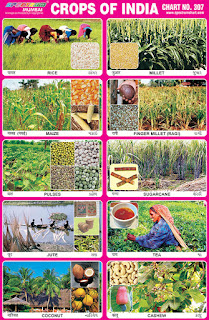 |
| Crops of India 1 Chart |
Spectrum Chart - 307 : Crops of India
1. Rice - Rice is a type of grain. It is
eaten as staple food in many parts of Asia. Rice used to be the main
diet in many countries. It is usually eaten cooked or boiled. China &
India are the leading producer of rice in the world. In India, rice
is grown in the eastern and western shoreline areas, Northeast India
and the drainage basin of river Ganga. Rice production comprises 42%
of the overall food crop production in the country.
2. Millet - Millets are grains for fodder
and human food. 97% of millet production in developing countries. The
crop is favoured due to its productivity and short growing season
under dry, high-temperature conditions. The most widely grown millet
is pearl millet, which is an important crop in India. India is the
world's largest producer of millet. Maharashtra cultivates about 52%
of the overall millet production in the country.
3. Maize - Maize is an important cereal of
India and is grown over 4 per cent of the net area sown of the
country. Maize is used both as food and fodder. Its grain provides
food and is used for obtaining starch and glucose. Maize is mainly a
rain fed kharif crop which is sown just before the onset of monsoon
and is harvested after retreat of the monsoon. More than half the
maize of India is produced in four states of Madhya Pradesh, Andhra
Pradesh, Karnataka and Rajasthan.
4. Finger Millet (Ragi) - In India, finger
millet is mostly grown and consumed in Karnataka, Rajasthan, Andhra
Pradesh, Tamil Nadu, Odisha, Maharashtra, Uttarakhand and Goa. Ragi
flour is made into flatbreads, including thin, leavened dosa and
thicker, unleavened roti. In India, Ragi recipes are hundreds in
number and even common food stuffs such as dosa, idli and laddu are
made out of ragi.
5. Pulses - Pulses are a type of
leguminous crop that are harvested solely for the dry seed. Pulses
are packed with nutrients and have a high protein content, making
them an ideal source of protein. Pulses are low in fat and rich in
soluble fibre, which can lower cholesterol and help in the control of
blood sugar. The top producer of pulses in India is the state of
Madhya Pradesh. The state contributes 24% of the overall pulses
production of the nation.
6. Sugar Cane - Sugarcane is one of the
several species of tall perennial true grasses. The world demand for
sugar is the primary driver of sugarcane agriculture. Sugar cane
accounts for 80% of sugar produced. Other than sugar, products
derived from sugarcane include falernum, molasses, rum, bagasse and
ethanol. Ethanol a byproduct of sugar production. It can be used as a
biofuel alternative to gasoline.
7. Jute - Jute is a long, soft, shiny
vegetable fibre that can be spun into coarse, strong threads. It is
produced primarily from plants in the genus Corchorus. Jute is one of
the natural fibres and is second only to cotton in amount produced
and variety of uses of vegetable fibres. India is the world's largest
producer of jute. Jute is used to make various products like
packaging materials, jute bags, sacks to expensive carpets,
espadrilles, sweaters etc.
8. Tea - Tea is a drink that is popular
all over the world. It is made by soaking the dried leaves or flowers
of the plant Camellia sinensis in hot water. China, India & Kenya
are the leading producer of tea in the world. Russia, UK &
Pakistan are the biggest importers of tea.
9. Coconut - Coconut is a mature fruit of
the coconut palm. Coconut is a complete food rich in calories,
vitamins and minerals. Coconut oil extracted from dry kernel (copra)
is an excellent emollient agent. Most of the world production is in
tropical Asia, with Indonesia, the Philippines and India accounting
collectively for 73% of the world total.
10. Cashew - Cashew is a tropical evergreen
tree that produces the cashew seed and the cashew apple. The cashew
seed, often simply called a cashew, is widely consumed. It is eaten
on its own, used in recipes or processed into cashew cheese or cashew
butter. Major production of cashews occurs in Vietnam, Nigeria, India
and Ivory Coast. India accounts for about 65% of global cashew
exports. India exports cashew kernels to over 60 countries.

No comments:
Post a Comment